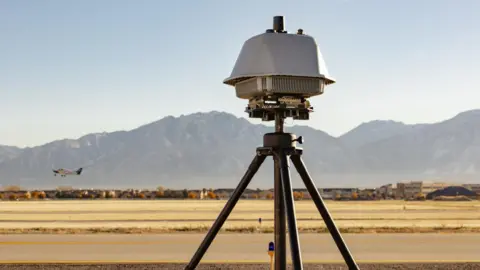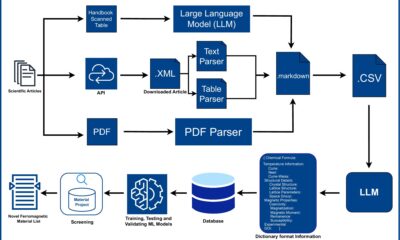Business
From florist to drone maker: How the weapon became so mainstream

Gideon LongBusiness reporter
 Kseniia Kalmus
Kseniia KalmusThe ongoing conflict in Ukraine is often described as the world’s “first drone war”. It has led to a continuing huge growth in the production of military drones, both within and outside Ukraine.
Before Russia’s invasion of Ukraine Kseniia Kalmus was a floral artist. She co-owned a flower shop in Kyiv and travelled around Europe showcasing her floral arrangements.
Now, she makes drones for use against the Russians.
“It was just an obvious decision for me,” she tells the BBC from the Ukrainian capital. “I just wanted to help my country, help my people and the military.”
Ms Kalmus says that after the war began back in February 2022, she raised money to buy anything the Ukrainian soldiers asked for, from vehicles to medicine and uniforms. But as time went by, the requests from the front line changed.
“I realised that all the requests were for FPV [first-person view] drones,” she recalled. “So I started raising money for that, specifically, and then I decided to produce them.”
These days, she and her fellow volunteers churn out hundreds of drones each month – small quadcopters with plastic X-shaped frames and a rotor blade on each corner – the kind of thing you might use to take aerial photographs at your wedding. Strap a small bomb to it though, and it becomes a deadly weapon.
Combat drones, delivery drones, surveillance drones, underwater drones – drones have become a key weapon of war globally, whether it be small hand-operated quadcopters, or high-tech military drones that look like small, unmanned aeroplanes and can travel long distances and cause enormous damage on impact.
Before 2022 there were just a handful of companies in Ukraine making drones. Now, there are hundreds. Kyiv says that around three-quarters of Russian losses on the battlefield are caused, not by bullets or conventional artillery, but by drones.
“This has been the first full-blown drone war,” says Stacie Pettyjohn, director of the defence program at the Center for a New American Security in Washington, and the author of several reports on drone warfare.
“There are a ton of mom-and-pop shops in Ukraine where people are making drones and assembling them in their apartments, in their garages and donating them to the forces. They’ve become the go-to weapon for the Ukrainians.”
And not just the Ukrainians. Drones are increasingly being used in conflicts from the Middle East, to Myanmar and Sudan.
“You see European states talking about building drone walls and other countries seeking to acquire drones because they provide them with a cheap form of air power.” Ms Pettyjohn says.
 AFP via Getty Images
AFP via Getty ImagesThe world’s biggest defence contractors, like Lockheed Martin and Boeing, are taking note, as are smaller drone-makers like US-based AeroVironment, which is listed on the Nasdaq stock exchange. Its share price has soared more than four-fold since Russia’s full-scale invasion of Ukraine.
In Europe, Portugal’s Tekever became what is known as a unicorn company this year – valued at more than $1bn (£760m) – and Germany’s Stark is expanding its drone-making operations. It is due to open a new factory in Swindon in southwest England at the end of November.
Meanwhile, the UK government announced last year that it would be spending £4.5bn on new military drones.
“The sector is growing really quickly,” said Mike Armstrong, Stark’s managing director for the UK. “I think drones are the future of warfare. Legacy systems – artillery, tanks – they all have a place, but what we’ve seen is a major innovation which is not going away anytime soon.”
The growth in drone use for military ends has spawned its antithesis – a counter-drone industry. For every drone launched in anger on the battlefield, there is usually someone trying to jam its radio signal or shoot it down.
Anti-drone technology is also increasingly being sought by Western nations to protect key infrastructure sites. The Belgian government announced on 7 November that it was urgently trying to acquire drone defences after drone sightings forced it to temporarily close Brussels Airport.
Oleg Vornik is the CEO of DroneShield, an Australian counter-drone company.
“We make hardware and software that you can carry in your hands, you can put on a vehicle or around the edge of a military base to detect and safely take down small drones,” he says.
Since 2022, DroneShield’s share price has soared 15-fold. “We are the only public-listed counter-drone company around the world, which has helped us,” Mr Vornik adds.
As well as supplying Ukraine, Mr Vornik says DroneShield is seeing increased interest from countries in the Asian Pacific, worried about China’s use of surveillance drones. DroneShield also sells to the governments of Colombia and Mexico, which use its technology to protect facilities from the use of drones by criminal gangs.
 DroneShield
DroneShieldMunin Dynamics is a much smaller start-up working in the same counter-drone space. Its founder is Magnus Freyer, a former paratrooper in the Norwegian army.
“We’re building a system that every soldier, whether they are a newly mobilised Ukrainian or an experienced Nato soldier, can use to defend themselves from drones,” he says. “It’s a small system that you can have a couple of in your vest, to shoot down the drone when it’s coming in.”
Experts say the next big development in drone technology is likely to be driven by artificial intelligence (AI).
At the moment, many drones used in conflicts are small, cheap devices that have to be guided to their targets by an operator – a human being with a remote control who needs to be within range of the drone, potentially placing them in danger.
But Ms Pettyjohn says that will change. “That is going to be the next real shift.
“Right now, really smart artificial intelligence is not very extensive. But you are going to start seeing groups of drones controlled by one operator, and then eventually fully autonomous drones that can collaborate.”
In the meantime, former floral artist Kseniia Kalmus says she will continue to assemble drones for use on the front line.
“I miss flowers very much and I miss that previous life, of course,” she says. “A lot of my friends, me as well, changed totally, from flower artists or from dancers to drone producers.
“But this is a question of existence. We just fight for our country, for our existence, for our culture.”
Business
Indias Wholesale Inflation Bottomed Out, May Still Remain Negative Through 2025-26: Report

New Delhi: India’s Wholesale Price Index (WPI) or wholesale inflation has “bottomholesale inflation bottomed out, may still remain negated out” and will probably gain slight momentum from November onwards, even as it may still remain in negative territory for most of the remaining months of 2025-26, Union Bank of India said in a report.
The Bank’s 2025-26 WPI forecast is currently tracking below 0.35 per cent amid what are being stated as subdued global commodity prices and a seasonal decline in food prices (with the impact of floods on food inflation seen to be capped).
“Food WPI remains depressed – spatial flooding and supply-chain disruptions did not materialise as expected, keeping food prices contained,” the report read. With 2025-26 Consumer Price Index (CPI) or retail inflation projections of the Union Bank of India also running sharply below the RBI’s latest estimates, it expects a 25 basis points repo rate cut in the upcoming December monetary policy review meeting.
While real GDP growth momentum remains robust, the report asserts that nominal GDP growth is expected to come under pressure due to subdued 2025-26 CPI and WPI projections. India’s wholesale inflation turned negative in October, with the Wholesale Price Index (WPI) recording a decline of (-) 1.21 per cent in October 2025 compared to the same month last year, according to official data released by the Ministry of Commerce and Industry on Friday.
A decrease in the costs of food articles, crude petroleum, natural gas, electricity, mineral oils, and basic metals mainly drove the fall in prices. The Ministry stated that the month-on-month change in WPI for October stood at (-) 0.06 per cent compared to September 2025.
The government releases the index number of wholesale price in India every month on the 14th of every month (or next working day, if the 14th falls on a holiday) with a time lag of two weeks of the reference month, and the index number is compiled with data received from institutional sources and selected manufacturing units across the country.
Inflation has been a concern for many countries, including advanced economies. However, India has largely managed to steer its inflation trajectory in a favourable direction. The RBI held its benchmark repo rate steady at 6.5 per cent for the eleventh consecutive time, before cutting it for the first time in about five years in February 2025.
Business
Gems trade slump: Exports fall 31% in October; bullion volatility, early US stocking hit demand – The Times of India

India’s gems and jewellery exports fell sharply in October, sliding 30.57% to $2.17 billion (Rs 19,172.89 crore) compared to the same month last year, according to data released by the Gems and Jewellery Export Promotion Council (GJEPC), PTI reported.Exports in October 2024 had stood at $3.12 billion (Rs 26,237.1 crore).GJEPC chairman Kirit Bhansali said the decline was largely expected, as overseas buyers had advanced their festive-season stocking before the US tariff came into effect.“Most of the stocking up for the festivals took place before August 27. Therefore, in October the demand was down. The decline in gold and silver exports is triggered by volatile bullion prices,” Bhansali told PTI.He added that exports should revive in November with Chinese market recovery and Christmas demand from major global buyers.Exports of cut and polished diamonds fell 26.97% to $1.02 billion (Rs 9,071.41 crore), down from $1.40 billion (Rs 11,806.45 crore) a year earlier.Shipments of polished lab-grown diamonds also saw a steep slide of 34.90% to $94.37 million (Rs 834.45 crore), compared with $144.96 million (Rs 1,218.25 crore) last October.Gold jewellery exports dropped 28.4% to $850.15 million (Rs 7,520.34 crore) from $1.18 billion (Rs 9,975.17 crore) a year earlier.Exports of coloured gemstones during April–October slipped 3.21% to $250.14 million (Rs 2,173.08 crore).Silver jewellery shipments dipped 16% in October to $121.37 million (Rs 1,072.81 crore), down from $145.05 million (Rs 1,219.01 crore) in 2024.
Business
Power Of SIP: Want Rs 4 crore In 29 years? Here’s How Much You May Need To Invest Every Month

Last Updated:
Embrace the power of compounding wealth by opting for a mutual fund SIP plan that suits your monthly income standards and risk capacity.

How much to invest to get Rs 4 crore as wealth? (Photo Credit: Instagram)
Looking to accumulate wealth to safeguard your future or build a significant retirement corpus? It is time for you to get your investment bone ticking instead of merely paying expenses from your monthly salary. It is time to embrace the power of compounding by investing a fixed amount every month in a Systematic Investment Plan towards a beneficial mutual fund scheme available in the market.
A Systematic Investment Plan entails a long-term investment strategy, where valuable interest is generated and earned on the principal sums invested. Most investors hope to generate enough gains to sustain their livelihood amid rising inflation and uncertainties. But what if an investor wishes to deal in crores at the end of the investment tenure, how much would they have to invest every month?
How To Earn Rs 4 Crore Via 29-Year-Long SIP Plan
If you invest through a Systematic Investment Plan that delivers an average annual return of 12 per cent, you can aim to accumulate over Rs 4 crore by the end of 29 years. To reach this goal, an investor would need to contribute Rs 15,000 per month throughout the investment period.
Over 29 years, the estimated gains generated from investing Rs 15,000 monthly at a 12 per cent return work out to Rs 3.58 crore. This figure is indicative and may change depending on market performance, economic conditions, and fund behaviour.
Total Earnings
If we combine the principal investment of Rs 52,20,200 (Rs 15,000 * 12 months * 29 years) with the capital gains achieved, we end with a total of Rs 4.1 crore. So you can start your investment journey with the ambition of reaching over Rs 4 crore in wealth by investing Rs 15,000 in a SIP mutual fund plan.
Before proceeding, however, individuals must do due diligence and consult a financial expert to identify the best scheme for them to invest in. Since mutual funds are subject to market risks, individuals with a poor risk appetite should be extra careful before investing.
A team of writers and reporters decodes vast terms of personal finance and making money matters simpler for you. From latest initial public offerings (IPOs) in the market to best investment options, we cover al…Read More
A team of writers and reporters decodes vast terms of personal finance and making money matters simpler for you. From latest initial public offerings (IPOs) in the market to best investment options, we cover al… Read More
November 15, 2025, 18:11 IST
Read More
-

 Entertainment1 week ago
Entertainment1 week agoChina unveils£5.4 bn Fujian, its most advanced aircraft carrier yet
-

 Politics1 week ago
Politics1 week agoIDF lawyers warned of possible Gaza war crimes: US intel findings
-

 Entertainment1 week ago
Entertainment1 week agoRobert Pattinson jokes about competing with Gen Z
-

 Tech1 week ago
Tech1 week agoThe Government Shutdown Is a Ticking Cybersecurity Time Bomb
-

 Sports1 week ago
Sports1 week agoIsraeli cycling team loses top sponsor despite honoring request to remove country from name
-

 Entertainment1 week ago
Entertainment1 week agoAlex Cooper apologizes to Taylor Swift for bizarre admission
-

 Tech1 week ago
Tech1 week agoMagnetic materials discovered by AI could reduce rare earth dependence
-

 Tech5 days ago
Tech5 days agoFrom waste to asset: Turning ethanol production CO₂ into jet fuel







